При включении компьютера или ноутбука с Windows 11 первое, что вас встречает после загрузки — экран блокировки, в зависимости от настроек — с выбранным вами фоном или фотографиями от Майкрософт, а уже после нажатия какой-либо клавиши или кнопки мыши — экран выбора пользователя и ввода пароля. При желании экран блокировки можно убрать.
В этой пошаговой инструкции подробно о способах отключить экран блокировки в Windows 11. Учитывайте, что это не уберет ввод пароля или ПИН-кода, если вам требуется именно это, используйте отдельную инструкцию: Как убрать пароль и ПИН-код при входе в Windows 11.
Отключение экрана блокировки в редакторе реестра

Первый способ убрать экран блокировки Windows 11 — использовать редактор реестра. Для этого выполните следующие шаги:
- Нажмите правой кнопкой мыши по кнопке «Пуск», выберите пункт «Выполнить», введите regedit в диалоговое окно «Выполнить» и нажмите клавишу Enter.
- В открывшемся редакторе реестра перейдите к разделу
HKEY_LOCAL_MACHINE\SOFTWARE\Policies\Microsoft\Windows
- Если в этом разделе есть подраздел Personalization, выберите его, иначе нажмите правой кнопкой мыши по выбранному разделу «Windows», выберите «Создать» — «Раздел» и создайте новый раздел с именем Personalization, а затем перейдите к нему.
- При выбранном разделе Personalization нажмите правой кнопкой мыши в правой панели редактора реестра и создайте новый параметр DWORD (32-бит, несмотря на x64 систему) и укажите имя NoLockScreen для него.
- Дважды нажмите по вновь созданному параметру и измените его значение на 1.
- Примените сделанные настройки и перезапустите проводник (это можно сделать в диспетчере задач) или перезагрузите компьютер.
Вместо ручного редактирования реестра, вы можете создать reg-файл со следующим кодом и «запустить» его, подтвердив импорт данных в реестр:
Windows Registry Editor Version 5.00 [HKEY_LOCAL_MACHINE\SOFTWARE\Policies\Microsoft\Windows\Personalization] "NoLockScreen"=dword:00000001
В результате экран блокировки будет отключен и, при следующем включении или после перезагрузки вы будете сразу попадать на экран выбора пользователя и ввода пароля или ПИН-кода.
В редакторе локальной групповой политики
Этот способ отключения экрана блокировки подойдет только для Профессиональной и Корпоративной редакций Windows 11, шаги будут следующими:
- Нажмите клавиши Win+R на клавиатуре, введите gpedit.msc и нажмите Enter.
- В редакторе локальной групповой политики перейдите к разделу «Конфигурация компьютера» — «Административные шаблоны» — «Панель управления» — «Персонализация».
- Дважды нажмите по параметру «Запрет отображения экрана блокировки».
- Установите «Включено» для параметра (именно это значение отключит экран блокировки) и примените сделанные настройки.
Результат тот же, что и в предыдущем случае — экран блокировки не будет отображаться при включении или перезагрузке компьютера.
Сторонние программы для настройки Windows
Многие сторонние утилиты для настройки Windows также позволяют выключить экран блокировки. Среди них:
В завершение статьи одно примечание: если в вашей системе включена функция «Безопасный вход в систему», требующая нажимать Ctrl+Alt+Delete при входе в систему, экран блокировки не может быть отключен. Саму опцию можно настроить в Win+R — netplwiz на вкладке «Дополнительно».
The Windows 11 lock screen features beautiful photos from around the world and transitions into the sign-in screen with the press of a button. But while it’s visually appealing, it adds an extra step to the login process many users wish to avoid.
In this tutorial, we’ll cover different ways to disable the lock screen in Windows 11 so that your PC opens on the login screen.
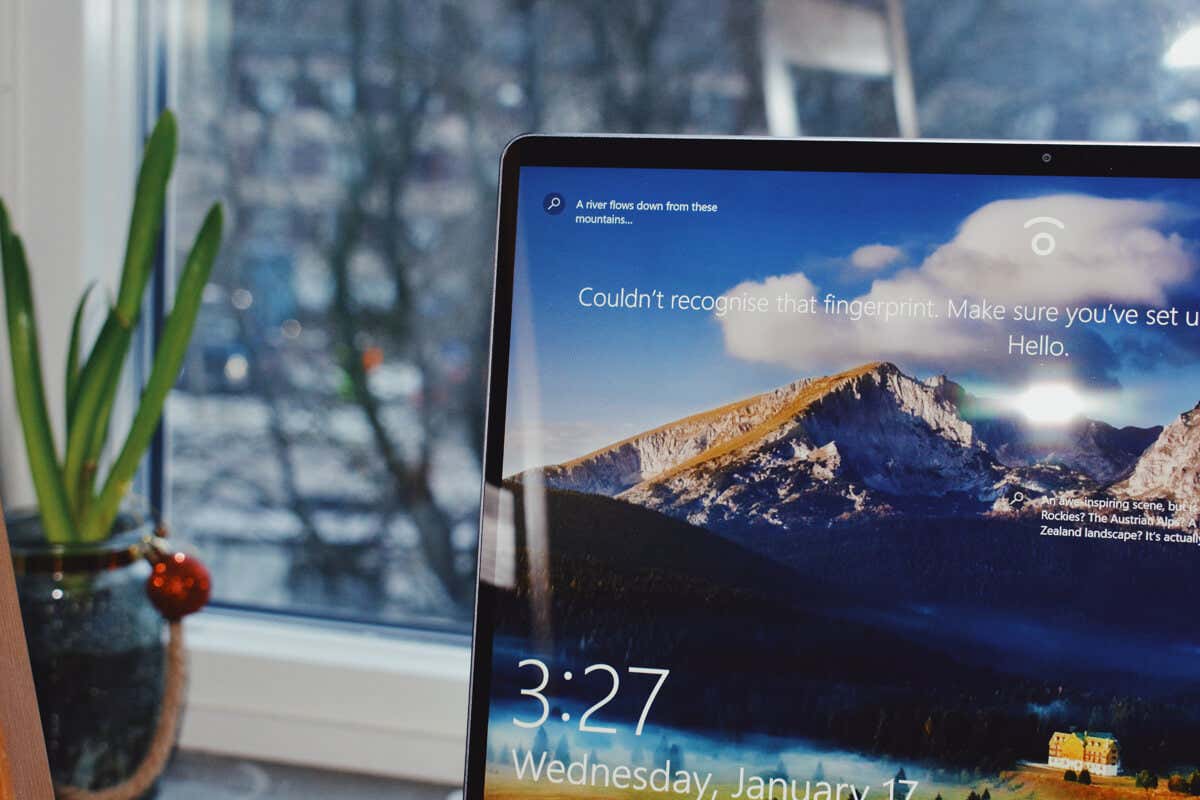
Why Disable Your Lock Screen?
The main reason to disable the lock screen is to speed up the sign-in process.
The Windows lock screen displays a background image, the date and time, and app notifications. While this is useful for many users, it doesn’t appeal to everyone. After removing the lock screen, Windows will take you straight to the login screen, where you can use any sign-in option to enter your computer.
Unfortunately, disabling the lock screen isn’t as straightforward as other customization processes when using Windows 11 Home, but it is still possible. Here’s what you need to do:
Disable the Lock Screen Using the Registry Editor
You can disable the lock screen using the registry settings. However, before editing your registry settings, you should export a copy of your registry. This will help you revert to your previous registry settings in case of an error or file corruption.
- Press the Windows key + R to launch the Run command box.
- Type regedit in the text input box and press Enter to launch Registry Editor.
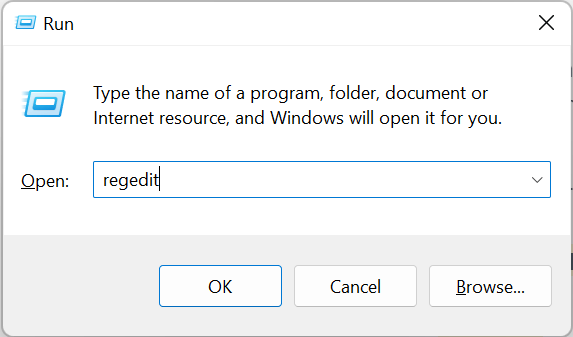
- In the navigation box up top, paste the following path and press enter: Computer\HKEY_LOCAL_MACHINE\SOFTWARE\Policies\Microsoft\Windows

- In the left-hand panel and right-click the Windows folder. Select New > Key and name it Personalization.
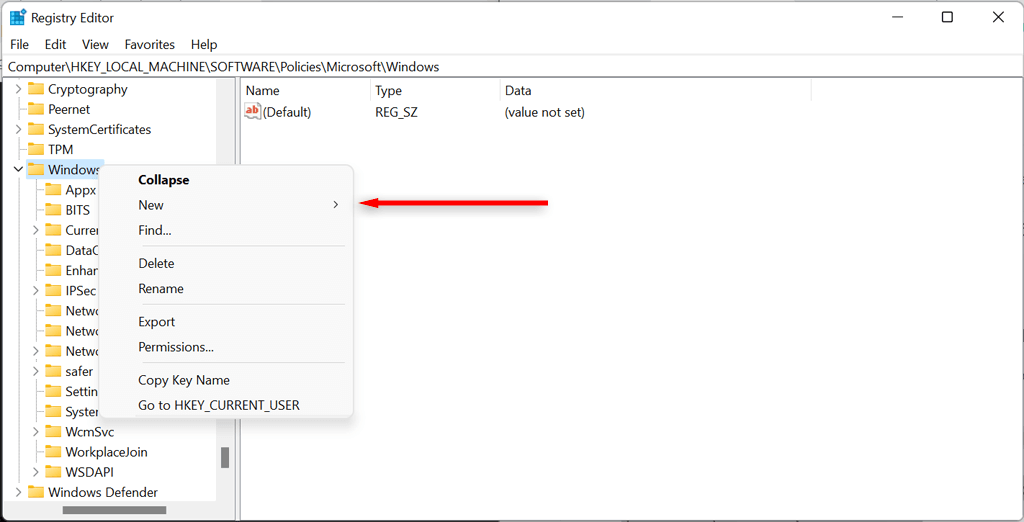
- Right-click the Personalization Key and select New > DWORD (32-bit) Value. Name it as NoLockScreen.
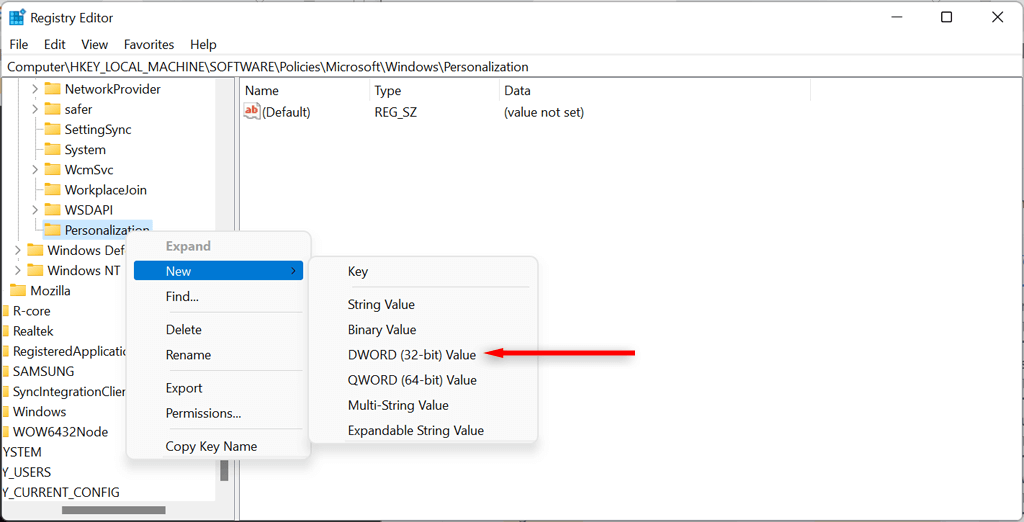
- Double-click on the NoLockScreen value in the right pane and set the Value Data to 1. Keep the base hexadecimal.

- Click on OK to apply changes and Restart your system. You won’t see the lock screen when your computer boots up.
- To bring back the lock screen, launch the Registry Editor again and paste the following into the address bar up top. Computer\HKEY_LOCAL_MACHINE\SOFTWARE\Policies\Microsoft\Windows\Personalization. Set the NoLockScreen key value to 0.
Disable the Lock Screen Using the Local Group Policy Editor
If you have Windows 11 Pro, you can use the Local Group Policy Editor to disable the lock screen.
- Use the keyboard shortcut Windows + R to launch the Run command box on your system.
- Type gpedit.msc and press Enter key to open the Group Policy Editor.
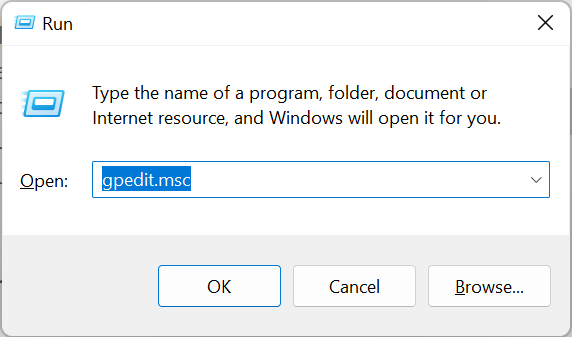
- Navigate to Computer Configuration on the left-hand side. Then go to Administrative Templates > Control Panel > Personalization. Under personalization options, Double-click the Do not display the lock screen option.
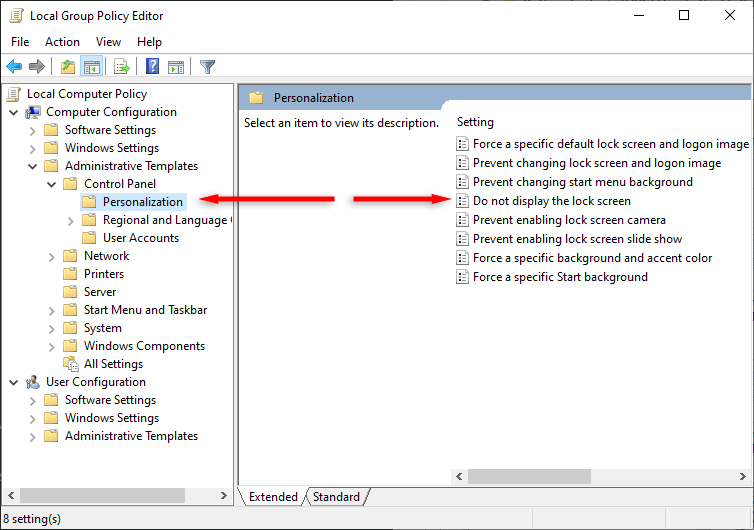
- In the new window, change the lock screen policy by clicking from the enabled option to the disabled option. Click on the Apply button and then the OK button to finalize the changes.
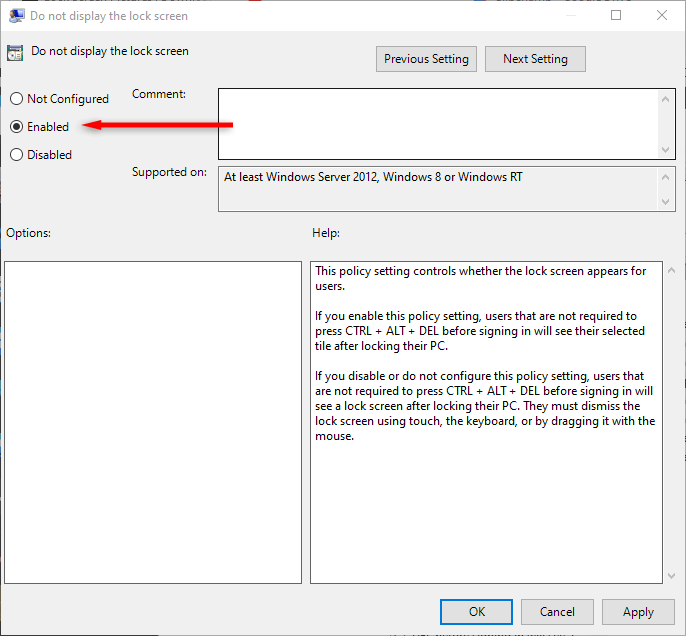
- Restart your system to initiate the changes. When your computer reboots, the lock screen should not appear.
Disable the Lock Screen Using Winaero Tweaker
Winaero Tweaker is a free app that allows you to customize Windows further than the Windows settings permit. However, we recommend using any registry editors with extreme care, as it’s easy to break your Windows operating system by implementing the wrong changes.
You can use it to disable the Windows lock screen as follows:
- Go to the Winaero website. Download and install the app.
- In the menu on the left-hand side, go to the Boot and Logon option.
- Under the Boot and Logon section, find the Disable Lock Screen option. Click on the Disable Lock Screen checkbox.
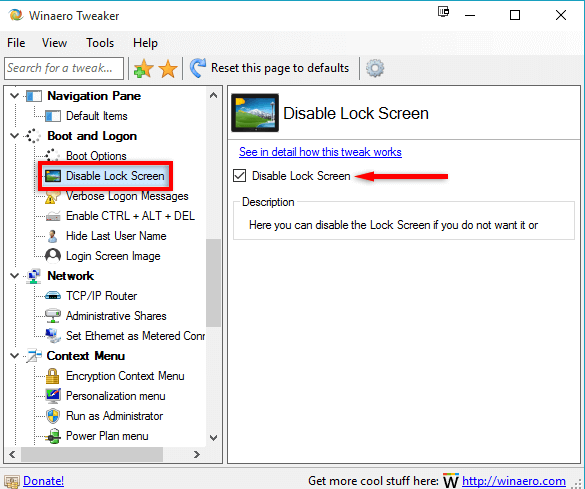
- Restart your system to apply the changes. You will notice that the lock screen doesn’t appear anymore.
Use Ultimate Windows Tweaker
Ultimate Windows Tweaker is an alternative to Winaero Tweaker. It makes it easy to disable the lock screen; however, it is wise to create a system restore point before you do to avoid causing the operating system to malfunction.
- Visit the Ultimate Windows Tweaker website. Download the app.
- Extract the Ultimate Windows Tweaker archive to a new folder.
- Right-click the UltimateWindowsTweaker.exe file, and select Run as administrator.
- Select Customization and check Disable Lock Screen checkbox. Then, select the Apply Tweaks button and close the program.
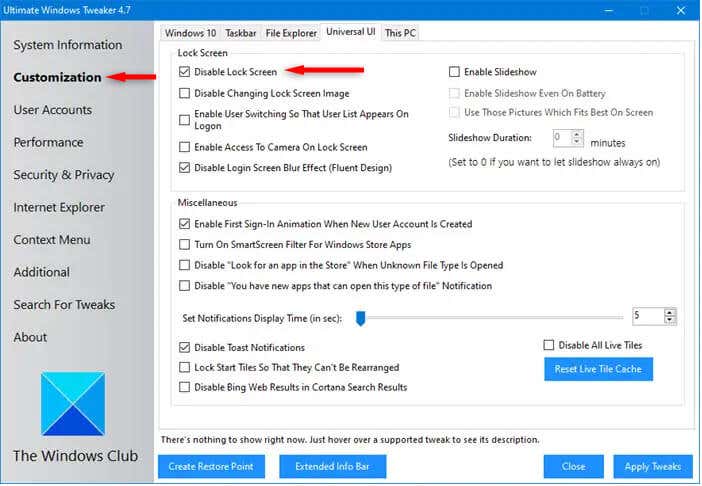
- Log out or restart your computer. The lock screen should not appear.
Lock Screen Begone
Using one of the above methods, you should be able to disable your lock screen and navigate straight to the login screen when you start your computer. If the registry editor or local group policy editor is too cumbersome, apps such as Winaero Tweaker and Ultimate Windows Tweaker make it easy to disable the lock screen.
Related Posts
- How to Fix a “This file does not have an app associated with it” Error on Windows
- How to Add OneDrive to Windows File Explorer
- How to Fix an Update Error 0x800705b4 on Windows
- How to Resolve “A JavaScript error occured in the main process” Error on Windows
- How to Fix the Network Discovery Is Turned Off Error on Windows
Майкрософт не позволяет отключить экран блокировки Windows 11 привычными способами. Благо, существуют непривычные!
Экран блокировки Windows 11 — это своеобразная картинная рама для компьютера, которая появляется сразу после его включения. На этом экране размещается любое доступное изображение, дата и время, а также состояние некоторых приложений, которые установлены в системе. По нажатию на любую кнопку вас сразу же перекидывает на экран входа в систему, где нужно вводить логин и пароль от учетной записи Майкрософт.
Вопрос: можно ли как-то деактивировать этот экран? Да, можно, причем не одним, а целыми тремя способами!
Как отключить экран блокировки Windows 11?
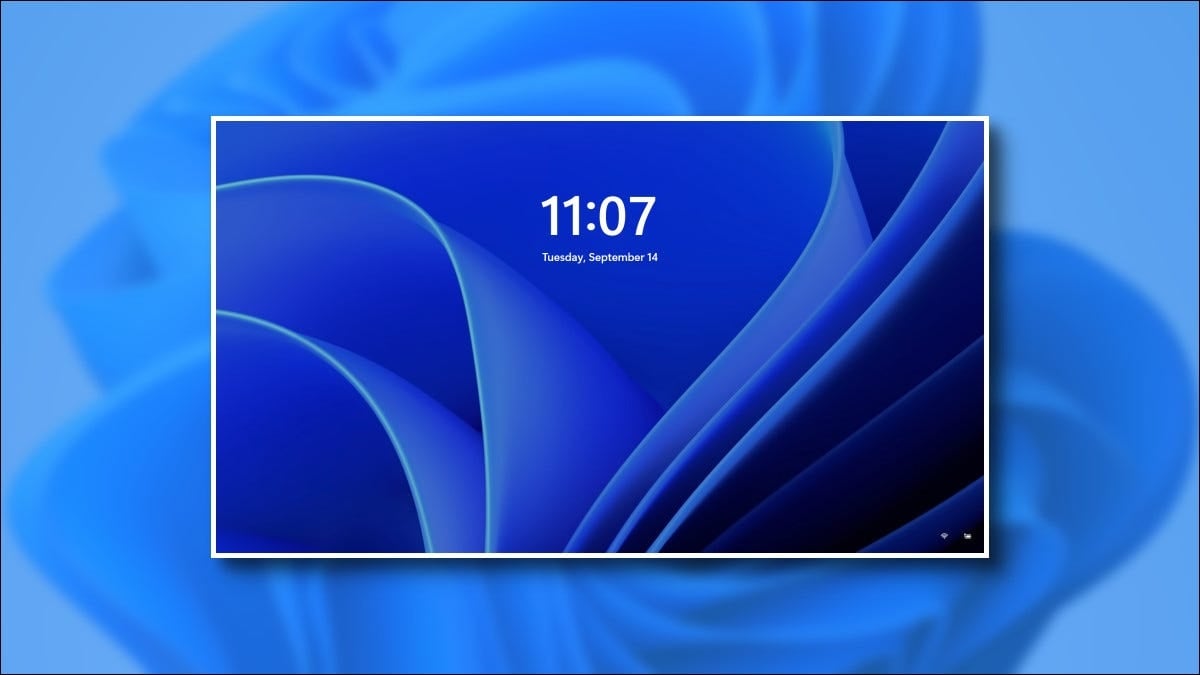
К сожалению, экран блокировки нельзя деактивировать через системные параметры. Майкрософт решили, что конечным юзерам не нужно давать какого бы то ни было выбора в данном отношении. Поэтому придется прибегать к услугам редакторов реестра и групповой политики.
Через редактор реестра Windows
- Нажмите WIN+R для вызова окошка «Выполнить»;
- пропишите в пустую строку regedit и нажмите ENTER;
- перейдите по пути HKEY_LOCAL_MACHINE\SOFTWARE\Policies\Microsoft\Windows\Personalization;
- кликните ПКМ на пустое место справа и создайте 32-битный DWORD;
- задайте новому параметру имя «NoLockScreen» и значение в единицу (1);
- сохраните внесенные изменения и перезагрузите ПК.
Через редактор групповой политики
- Нажмите WIN+R для вызова окошка «Выполнить»;
- пропишите в пустую строку gpedit.msc и нажмите ENTER;
- пройдите по пути:
- ↓Конфигурация компьютера;
- ↓Административные шаблоны;
- ↓Панель управления;
- ↓Персонализация;
- найдите «Запрет отображения экрана блокировки» и дважды кликните на него ЛКМ;
- задайте параметру значение «Включено»;
- подтвердите изменения и перезагрузите ПК.
Отключение экрана блокировки Windows 11 сторонним ПО
Не хотите возиться с системными средствами? Ладно, тогда предлагаем обратиться за помощью к сторонним средствам: Winaero Tweaker и Ultimate Windows Tweaker. Две довольно известные утилиты, которые помогут вам деактивировать надоедливый экран в считанные секунды. Сейчас мы проведем вас по необходимым пунктам меню:
- Winaero Tweaker
- BootAndLogon→DisableLockScreen
- Ultimate Windows Tweaker
- Customization→UniversalUI→DisableLockScreen
Отключить экран блокировки Windows 11 очень просто, в чем вы могли убедиться выше. Если у вас остались еще какие-то вопросы по теме, пожалуйста, оставляйте их в комментариях под статьей.
Readers help support Windows Report. We may get a commission if you buy through our links.
Read our disclosure page to find out how can you help Windows Report sustain the editorial team. Read more
Windows 11, like other platforms in its series, has a lock screen you’ll see just before logging into your user account.
That lock screen displays the time, date, one app status icon, and a magnifying glass icon. Clicking on the magnifying glass icon brings up the login text box and screen.
The lock screen also has a Windows + L keyboard shortcut. Pressing that hotkey returns you to a lock screen, from where you’ll need to click and then log back into Windows.
Do I need to have the lock screen enabled on my Windows 11 PC?
Although the lock screen displays date/time info and an app status icon, it’s hardly a necessity. Some users might prefer to disable it so they don’t need to click to reach the login screen.
There isn’t an option in Settings that turns off the lock screen, but you can still disable it with the methods below.
Has the lock screen changed in any way in Windows 11?
Microsoft has made some relatively minor changes to Windows 11’s lock screen. It has a new default Windows 11 background wallpaper for one thing. However, you can change that wallpaper via Settings.
You’ll also notice the date/time info has changed position on Windows 11’s lock screen. Now it displays that info at the top center of the screen instead of the bottom left corner. The clock time text also has a bolder font type.
However, those are only small changes Microsoft has applied to the lock screen. There isn’t that much difference between the lock screens in Windows 11 and 10.
So, it’s unlikely users who didn’t want Windows 10’s lock screen enabled will want to keep it after upgrading to 11.
How can I turn off the lock screen in Windows 11?
1. Edit the Registry
- Right-click the taskbar button for the Start menu and select Run.
- To open the Registry Editor, input the following text and press Enter:
regedit - Next, open this registry location:
HKEY_LOCAL_MACHINE\SOFTWARE\Policies\Microsoft\Windows - Right-click Windows on the left side of the Registry Editor and select New > Key.
- Type Personalization in the key’s text box.
- Right-click the Personalization key and select the New > DWORD (32-bit) value options.
- Enter NoLockScreen to be the DWORD’s title.
- Double-click NoLockScreen to open an Edit DWORD window for it.
- Input 1 within the Value data text box, and click OK to apply.
- Open the Start menu, select Power, and click Restart.
2. Use the Group Policy Editor
-
1. Bring up the Run dialog (it has a Windows + R keyboard shortcut).
-
2. Open Group Policy Editor by entering this command and clicking OK:
gpedit.msc -
3. Next, click Computer Configuration and Administrative Templates.
-
4. Select Control Panel > Personalization to open the policy setting shown directly below.
-
5. Double-click the Do not display the lockscreen policy.
-
6. Then select the Enabled radio button.
-
7. Press the Apply and OK buttons to save the setting.
A great tool you can use to turn off Windows 11’s lock screen is none other than the Group Policy Editor. It is built-in on your PC and can be safely used to tweak any PC options you want to.
NOTE
Windows 11 Home edition doesn’t include the Group Policy Editor. However, you can enable Group Policy Editor in the Home edition as outlined within our How to enable Gpedit.exe in Windows 11 guide.
- How to customize the lock screen in Windows 11
- How to access Advanced System Settings in Windows 11
- How to Find the Refresh Button on Windows 11
- How to make Windows 11 faster and more responsive
3. Disable the lock screen with Winaero Tweaker
- Open the Winaero Tweaker page, and click the Download Winaero Tweaker link there.
- Press the File Explorer button on the taskbar.
- Open the folder the Winaero Tweaker downloaded to, and double-click the winaerotweaker file to open it.
- Press the Extract all button that’s on the command bar.
- Click the Show extracted files when complete checkbox shown directly below to select that option.
- Select Extract to do so.
- Double-click WinaeroTweaker-1.33.0.0-setup to open the setup wizard and install the software.
- Open the Winaero Tweaker window, and double-click the Boot and Logon category.
- Select the Disable Lock Screen option on the left of the window.
- Then click the Disable Lock Screen checkbox on the right.
- How to customize the lock screen in Windows 11
- Lock screen not working in Windows 11? Here’s how to fix it
- Windows 11’s lock screen Spotlight not working? Try these fixes
- Windows 11’s lock screen slideshow not working? Try these fixes
Can I disable the Windows login screen as well?
Not exactly, but you can bypass the login screen by configuring Windows to automatically sign in for you. Then you won’t ever need to manually log in to Windows.
To do so, you’ll first need to edit the registry and deselect the User must enter a user name and password to use this computer as follows.
- Open Registry Editor as covered within the first two steps of method one.
- Go to this registry key location:
HKEY_LOCAL_MACHINE\SOFTWARE\Microsoft\Windows NT\CurrentVersion\PasswordLess\Device - Double-click the DevicePasswordLessBuildVersion DWORD for the Device key.
- Then erase the current value from the data box, and enter 0 to replace it.
- Click OK to confirm.
- Thereafter, close the Registry Editor.
- Open the Run dialog.
- Enter this Run command and click OK:
netplwiz - Deselect the Users must enter a username and password to use this computer checkbox.
- Press the Apply button to save the new settings, and click OK to close the window.
You can also disable the lock screen on Windows Server with different methods. Our how-to Disable Lock Screen on Windows Server guide provides full details on how you can do so.
So, that’s how you can disable the lock screen in Windows 11 with three different methods. It’s relatively straightforward to enable that screen by editing the registry as outlined above. You can also set up a System Restore point beforehand just in case.
If you prefer not to edit the registry, however, you can disable the lock screen with Winaero Tweaker instead. That’s a great freeware customization app with which you can customize Windows 11/10 in many ways. So, it’s worth checking out Winaero for much more than just disabling the lock screen.
We hope you managed to successfully turn off Windows 11’s lock screen using our methods. Write to us in the comments section below if you have any thoughts you want to share with us.
Matthew Adams
Windows Hardware Expert
Matthew is a freelancer who has produced a variety of articles on various topics related to technology. His main focus is the Windows OS and all the things surrounding it.
He is passionate about the tech world, always staying up-to-date with the latest and greatest. With an analytical view, he likes problem-solving, focusing on errors and their causes.
In his free time, he likes to read and write about history and tries to always develop new skills.
Apart from disabling typical account passwords, users can disable the login screen Windows 11 to get into the main screen faster. This guide is about how to disable login screen and password for Windows 11 in case some people who tired of entering password and login screen again and again. Here also teaches you how to add the login screen back when you want it.
Note: Disabling login screen doesn’t mean that you can go directly logon screen without password/pin code, that means you can enter the desktop with password/pin code without seeing the time, wallpaper or applications’ notification. If you want to login faster, then remove the password using UnlockGo for windows after disabling login screen.
Part 1. How to Disable Login Screen and Password Windows 11
To make any change in the Windows settings, you need to have the account password to login to the computer. Only an authorized person can make the changes, but sometimes the users don’t have the account password for Windows 11. In this situation, there are different methods to overcome the problem of disabling the login screen and password for Windows 11.
Section 1: Disable Login Screen Password when Locked out of Windows 11
When the system is locked with password protection and you don’t have the password, UnlockGo – Windows Password Recovery can help you to bypass and remove the password. Here are simple steps that you need to follow to remove the Windows password first:
🔑 Step 1: Install UnlockGo – Windows Password Recovery Tool to Create Windows Password Reset Disk.
Users can install the tool on any other laptop or computer that is easily accessible. The installation process is quite easy and straightforward. And click Start to burn it.
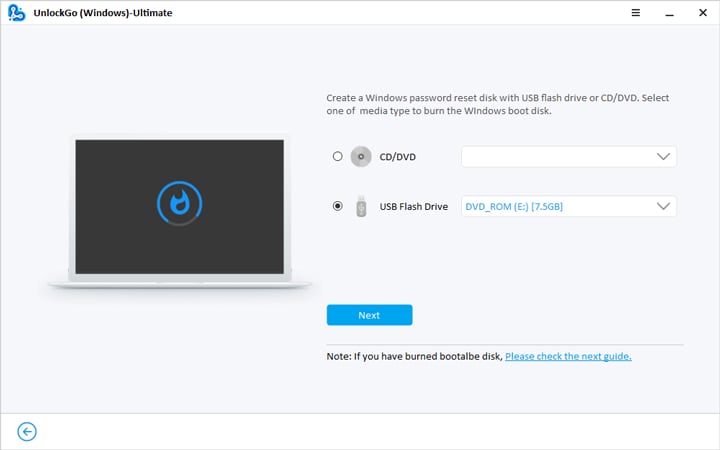
🔑 Step 2: Insert Burn Disk into Locked Windows 11 and Enter BIOS Menu.
Insert that USB or disk into the locked computer, press F12 or ESC for most computer to enter boot menu, choose the boot tab using arrow key, then select the boot device priority, click F10 save and exit.
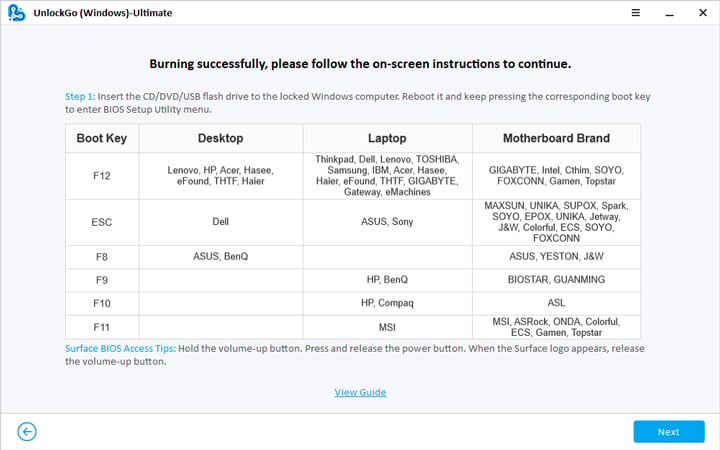
🔑 Step 3: Choose Target Account to Reset/Remove Login Password.
After the reboot, you will see the interface of the tool on the locked computer and choose you windows version and then you can choose the target windows account to remove account password. Choose ‘Remove Account Password’ and click next, and you can choose other options as well.
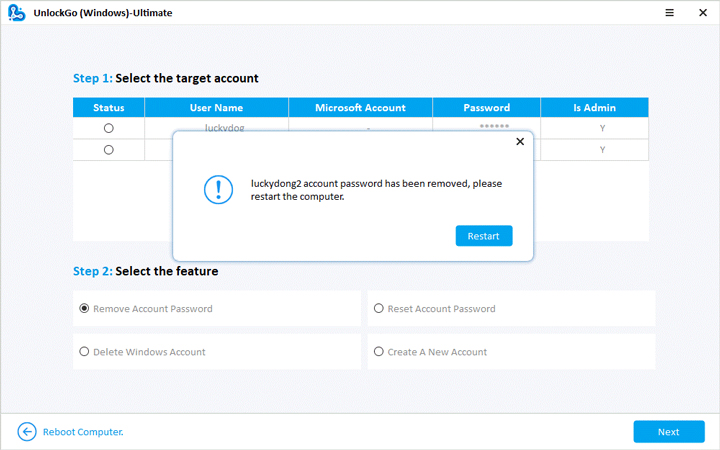
Then you can get into your device without password even if you forgot it.
Section 2: Disable Login Screen Windows 11 after Logging In
The other condition is to disable the login screen after logging into the system, and this method is quite simple as you don’t need to bypass the system’s security. Still, users got two different options to make this happen. Let’s have a look at both options and methods in detail.
Way 1: Windows 11 lock screen group policy
You might have already used the registry editor for some other tasks, and this login screen removal process via group policy editor is quite similar to that one. Here are steps that will allow you to remove the lock screen by using the group policy editor.

- Go to the start menu and search for ‘Edit Group Policy’, and choose ‘Computer Configuration’ from the newly opened window.
- Now, keep following the further items appearing on the left pan: Computer Configuration>> Administrative Templates>>Control Panel>> Personalization.
- Upon clicking the Personalization option, you will be displayed different options in the right pan.
- Choose the ‘Do not display the lock screen’ option and click on the enabled button, and press ok.
Way 2: Windows 11 lock screen registry editor
This method is like a manual way to disable the lock screen, and it will allow the user to get the same thing done with different steps. First of all, an open the Run window by pressing the Windows button plus R.
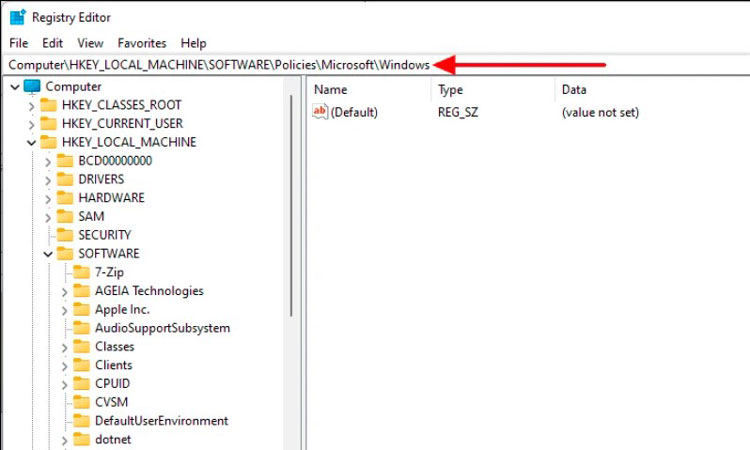
- Type ‘regedit’ in the Run bar and press enter.
- Once the new window has opened, paste the given path in the search bar of this new window.
Computer\HKEY_LOCAL_MACHINE\SOFTWARE\Policies\Microsoft\Windows
- Now, click on Windows>>New>>Key from the expanded menu.
- Assign ‘Personalization’ title to newly created key.
- Create a new string by clicking in the right panel: New>> ‘DWORD (32-bit) Value’ from the expanded menu.
- Change the name of this key to ‘NoLockScreen’ and enter 1 after clicking this key and click ok.
After this process, all changes will be saved for windows 11, and you will not get any login screen password next time. As for disabling windows 10 admin/lock screen password, check this one, you will know everything.
Part 2. How to Add Login Screen Windows 11 Back
Are you not satisfied with turning the lock screen off and want to have it back to enjoy the multiple interfaces of your computer. Well, there are some ways to get the login screen back.
Way 1: Shortcut: Ctrl + Alt + Delete combinations
This method involves using some key combinations, but you can make it work to get the login screen back:
- Click anywhere on the lock screen, and it will take you to the next window.
- Press the combination of Ctrl +Alt +Delete, and this will take you to the login screen where you can enter your password.
Way 2: Run Startup Repair
If the option is turned off due to some technical reason, repairing Windows may solve the issue. Here is how to resolve to disable password windows 11:
- Turn off PC.
- Turn the PC and then turn it off by pressing the power button and repeat the process two times and you will see the ‘Preparing Automatic Repair’ message.
- Choose advanced option message and choose troubleshoot>> Advanced Options>> Startup Repair.
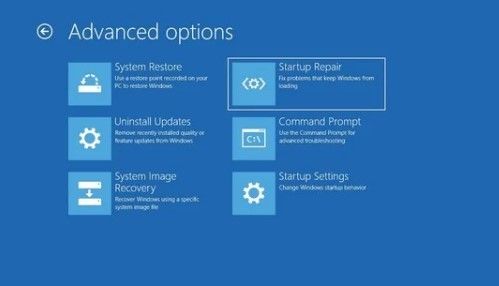
Way 3: Create a new user account
There is something wrong with the previous user account; you can create a new one, and here is how to do it.
- Boot safe mode and press the Windows button, and I key at the same time.
- Click accounts>>other people>>add someone else on this pc.
- Set a new user account on the computer and now restart the pc, and the lock screen will show you the login screen.
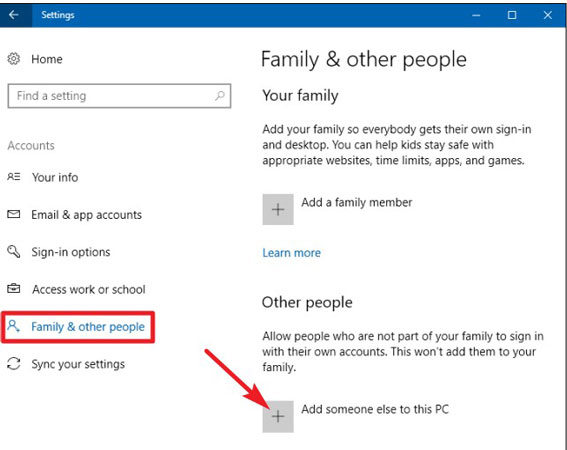
Bonus Tips for Login Screen Windows 11
Here are some practical tips that can make the whole process a lot easier for you. Follow these tips:
❓ 1. Windows 11 Lock Screen Timeout
The easiest way is to make changes through the control panel. Here is the path: control panel>>power options>>change plan settings>>change advance power settings>>console lock display off timeout>>set the time for the lock screen.

❓ 2. Windows 11 Auto Lock Screen
Just like the process mentioned before, you can make changes in the advanced power settings where you can set the ‘turn off my screen’ option to never and the laptop will not automatically lock the screen.
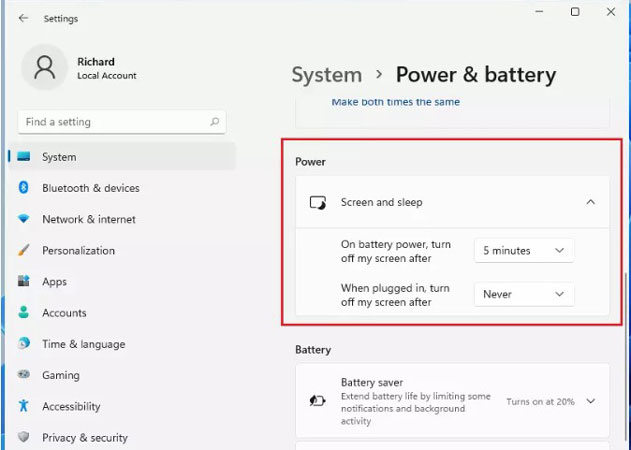
❓ 3. Windows 11 Disable Lock Screen after Sleep
In the advanced power settings, you can change the lock screen setting after sleep. Go to the after sleep option and make the desired changes that you want to apply after putting your laptop to sleep.
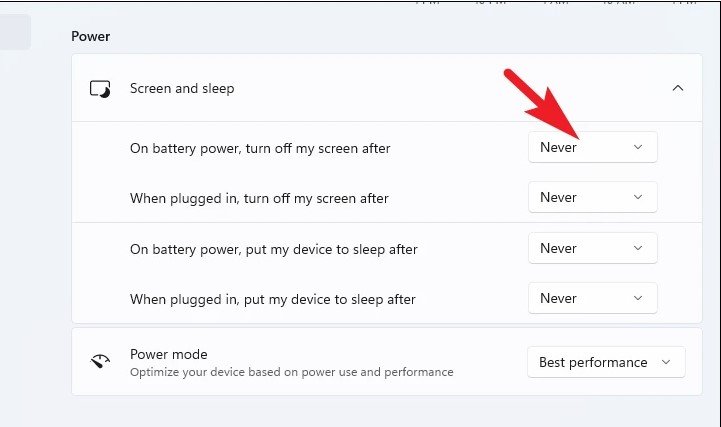
Conclusion
All of these methods to disable the login screen Windows 11 work differently for different situations. The problem here is to make changes without having a password, and UnlockGo – Windows Password Recovery has the right solution for that problem too. If you are ever locked out of your computer or forgot your Windows password, UnlockGo can save your day.
UnlockGo (Windows)
- Reset/Remove Windows Local, Admin, Microsoft, Domain account passwords without Current Passwords.
- Create a Password Reset Disk with One Click.
- It Supports All Windows Versions from the Latest to the Oldest.



























